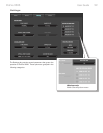
User Guide 25ProFire 2626
Optical Port B Mode
This portion of the Control Panel determines how the second pair of optical ports on the rear of the interface
will operate. Setting this parameter to “ADAT” will allow ProFire 2626 to receive or send 16 channels of
44.1/48kHz signals, eight channels of 88.2/96 kHz signals, or four channels of 176.4/192 kHz signals by
using both optical ports in tandem.
Selecting “S/PDIF” will allow the second optical input and output ports to receive and send stereo S/PDIF
signals. Note that optical S/PDIF operates at a maximum sample rate of 96 kHz.
S/MUX Mode
Each ADAT optical cable can carry eight channels of audio when operating at standard sample rates of 44.1
or 48 kHz, four channels when operating at sample rates of 88.2 or 96 kHz (S/MUX II Mode), or two channels
while operating at 176.4 or 192 kHz (S/MUX IV mode). These high resolution modes are known as
“S/MUX II” and “S/MUX IV” and are enabled when an ADAT source toggles a special bit in its output stream.
This bit tells the destination device to switch to the proper S/MUX mode in order to receive the high resolution
signal correctly.
Unfortunately, some devices that are capable of S/MUX II or S/MUX IV operation do not set the S/MUX bit
correctly and, as a result, the ProFire 2626 may be unable to automatically detect the desired sample rate. The
“S/MUX Mode” option resolves this issue:
Auto– This is the default setting and should work in most cases. When this mode is selected,
ProFire 2626 observes the S/MUX bit of an incoming signal and automatically switches between standard,
S/MUX II, and S/MUX IV modes.
S/MUX II (88.2-96 kHz) – This parameter sets the ADAT input ports to operate in S/MUX II mode. Only
use this option if the default “Auto Detect” setting does not correctly recognize the sample rate of the
incoming signal.
S/MUX IV (176.4-192 kHz) – This parameter sets the
ADAT input ports to operate in S/MUX IV mode. Only use
this option if the default “Auto Detect” setting does not
correctly recognize the sample rate of the incoming signal.
NOTE: This parameter only affects
the ADAT inputs when the Sync
Source parameter is set to “ADAT A”
or “ADAT B.”


















